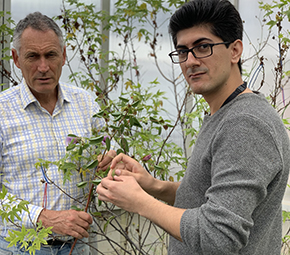 As climate change intensifies, the very shirts on our backs are at risk as heat damage to pollen raises the prospect of catastrophic cotton crop failures.
As climate change intensifies, the very shirts on our backs are at risk as heat damage to pollen raises the prospect of catastrophic cotton crop failures.
Experiments conducted in the Atwell Lab at the Department of Biological Sciences showed that cotton pollen grains exposed during their formation to temperatures above 36 degrees lost their capacity to fertilise and produce their precious lint.
“The heat damage to plants is very specific to pollen grains (the male cell line) and cotton is no exception, with the lint-filled bolls failing to form after a one- or two-day heatwave at the vital stage in pollen formation,” says plant physiologist Professor Brian Atwell.
“If we were to get an extended run of 40-degree days about a fortnight before anthesis – the moment the pollen fertilises the ovary – then we could have a major wipe-out.”
There are lots of examples of crops being essentially rendered sterile because of frost events but there is less knowledge about how heatwaves affect pollen.
The Lab has mapped the thousands of proteins found in mature cotton pollen after brief heatwaves, opening the way for the targeting of individual genes and modifying pollen to develop more heat-resistant cotton cultivars. Atwell’s group also applies proteomic analysis to the wild relatives of modern crop species, exploiting the rich genetic resources that have evolved in the harsh and hot conditions of northern Australia.
“We chose cotton because in the theme of everything we do at the Lab, we are interested in agricultural plants and their closely related wild Australian ‘relatives’” explains Atwell, whose previous discovery of a heat-resistant protein in wild rice is now in the development phase in genetically engineered wheat.
“We focussed on pollen because it has long been known that pollen cells are highly susceptible to extremes of temperature, just as sperm cells are in mammals.
“There are lots of examples of crops being essentially rendered sterile because of frost events but there is less knowledge about how heatwaves affect pollen.”